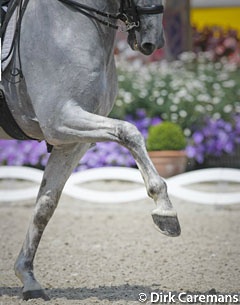
Nuno Oliveira used to say "impulsion was the aspirin of equitation" and "lightness is the fruit of impulsion." Before starting an exercise what is needed? Impulsion! To resolve a problem what is needed? Impulsion! However, a common error for riders is to mistake speed for impulsion, and the great master knew that the art of impulsion lay not in the leg speed of the horse, but in the energy generated by his mind.
"Impulsion has nothing to do with speed. Impulsion begins by the mind of the horse, not by his legs," Oliveira expained.
Yet, still we see people roaring around the arena trying to fake impulsion with the use of force, but the art of dressage lies in creating energy with invisible aids. "To increase impulsion, increasing the speed is a false but easy solution. What is needed is to increase the energy without increasing the speed," my hero Oliveira explained.
Thus riders must create impulsion through exercises, which engage the horse's mind and body in the work. Oliveira recommended that the sequence of exercises creates impulsion because the horse is obliged to be attentive and to work. So what are the signs your horse is lacking impulsion?
One is straightness, and a horse that is curving and farting about in all different directions, is probably signalling a lack of forward energy. The more impulsion a horse has, the more forward he is, the easier it is to keep him straight. Also, a horse that is sucking back and coming off the contact is likely loosing his energy out the back door and will need to rebalance and gain more forward energy in order to regain an elastic contact.
"When the horse loses the contact and moves his head, push because he is losing the impulsion," Oliveira stated.
Expert dressage trainer Jan Bemelmans believes that "impulsion is like the motor that pushes you forwards," and the difficulty lies in turning that motor power into upward lift, rather than forward running. "The most difficult part about impulsion is learning to control the power, in order to bring it into a horse that is carrying that energy, rather than a running movement," said Jan.
According to Bemelmans, without enough impulsion, the horse will get lazy, and lose the expression of the movement. So, is it possible to have too much impulsion? Jan says yes and while a horse will great power and energy seems ideal, if the rider cannot control that forward power, then this is not what we want in dressage.
"We need to be able to control the power so we can bring the horse in balance," he expmained. "If you have too much impulsion, the rider becomes more a passenger than a driver."
Adamant that impulsion is very important to the realms of dressage, Jan knows that it's equally important for the rider to harness that impulsion and create a partnership in the arena "Dressage without impulsion would be .....Boring," Jan joked. So what is the main cause of too much impulsion?
Typically speed is a result of riders using too much constant leg, which ends up with a horse actually behind the rider's leg and with a rider who needs to bash and crash about constantly to keep the horse moving. This is not impulsion, it is just a rider who is overriding and causing the horse to become lazy.
For true impulsion to be created, the horse must of course be in front of the rider's leg, which means they must react off a light aid. Once your horse learns to move off a light aid, he can maintain the forward motion on his own and then you can use the leg effectively to engage, balance, and boost the impulsion or upward energy.
If your legs are already going full pelt just trying to keep the horse moving, how do you expect to create more impulsion for the more difficult exercises? If we take Nuno Oliveira's description of impulsion as "a mental and physical state of the horse to obey the rider's demands as fast as possible, to move forward, and to maintain his forward impulsion without support from the aids," we can think of impulsion more as the reactivity and not the activity of the horse. More simply, impulsion or reactivity is the immediate response to a light leg aid and the horse demonstrating the will to go.
The FEI defines impulsion in the test directives criteria first and foremost as the desire to move forward. It also includes the quality of that forward motion- engagement of hind quarters, elasticity of the steps, suppleness of the back. All of which come when you have a horse in front of you, off a light aid, and willing to move forward.
Then, once you have a horse that is saying "I'm willing to move forward easily off a light aid"? You say, "super, I'll take that willingness to move forward, and raise you a willingness to move forward in an upward, balanced direction. Thanks!"
by Sarah Warne for Eurodressage
Photo © Dirk Caremans
Related Link
Sarah Warne's Classical Training Articles